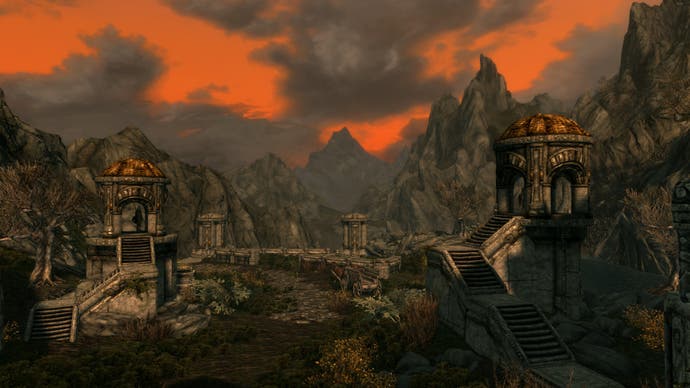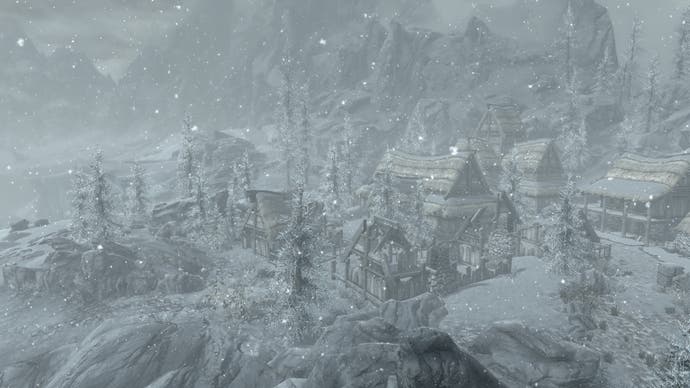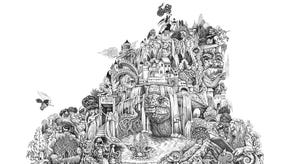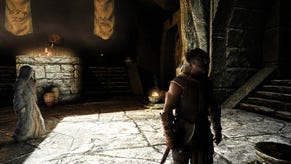On the secret smallness of Skyrim
Turning molehills into mountains.
Skyrim's dirty little secret is that it isn't that large. Oh, it remains fairly gigantic by the standards of other virtual landscapes, even next to its youthful imitator and usurper, The Legend of Zelda: Breath of the Wild. But set against what it pretends to be - a kingdom stretching from arctic wastes to the temperate south, racked by dynastic squabbles and laced with the treasures and detritus of millennia - it's actually pretty dang tiddly, a little over 14 square miles in scope.
14 square miles? That's no bygone, mystery-shadowed dominion rearing its shrines and watchtowers amid sunflashed snow. That's a jumped-up theme park, a country music festival. More to the point, that's approximately the same size as The Elder Scrolls 4: Oblivion, a game which has become something of a punching bag for Elder Scrolls aficionados in hindsight - neither as grand as its swaggering barbarian brother, nor as memorably odd as burned-out hippy uncle Morrowind. Steer clear of distractions like temperamental mammoth herds and you can walk from one side of Skyrim to the other in half an hour.

I'm being quite obtuse, of course. If open world games were required to be as large as their inspirations or narrative aspirations they'd never get finished, and in any case, who would have the time to play them? The fascinating thing about open world design is that it's not really about size at all. It's more the art of the deceptive miniature - of making the poky or digestible seem enormous to the point of exhausting, even as distant cities reveal themselves for neighbouring hamlets, fearsome mountains for mere well-appointed foothills. Skyrim is extremely good at this, to a degree I'm not sure any game environment can rival save the corkscrew terrain of the original Dark Souls. It launches on Switch this week, glory of glories, and I've spent a few hours with the remastered PC version to remind myself of its achievements.
A few months ago there was a great Twitter thread about Breath of the Wild's use of triangular and rectangular silhouettes to rouse and thwart curiosity, layering up the geology and architecture to create tacit routes and kindling suspense around remote landmarks. You can trace much of that to Skyrim, whose mountain ranges are invaluable not just for their particular majesty or the traps and catacombs they house, but for how they rend and twist the map, occluding, exposing and magnifying in a way Oblivion never managed.

Having thrown together a new character, I cheerfully turned my back on starting town Riverwood and embarked on a tour of the major cities, from southern Falkreath to the ancient dwarf fortress of Markarth and up to Skyrim's clifftop capital, Solitude, then across the coast to the Mage's College of Winterhold and down to Windhelm, seat of the Stormcloak rebellion. The roads between settlements aren't long nor especially hard to follow, but goodness me, how long they feel, as each turn, dip or rise unveils some gloomy immensity that vanishes from sight just as swiftly. To walk this kingdom is to weather a perpetual play of horizons and distances, your attention moving irresistibly from near to far and back again. There's that beautiful moment when you spy Winterhold peeking over the shoulder of a range, tempting you to leave the path (and risk being set upon by wolves) in hopes of an uninterrupted view. There's the mild uncertainty as to whether a hazy, barbed shadow is another peak, or the exploded ribcage of an old Nord temple, and the delight of cresting a rise to find a watermill churning peacefully at the bottom of a valley.
Part of the thrill is that the landscape strays just close enough to a naturalistic portrayal that such vistas feel unforced, a compromise between geological process and the designer looking to ensure that threats, havens and opportunities are evenly spaced. Passages between holds are credibly the result of rivers eating through the burst edges of folded continental plates. Near Falkreath, hard-wearing boulders wallow in coarse soil, possibly carried there by long-melted glaciers, their lips hung with roots and tiny alpine flowers. There's a caldera above Riften, an enormous basin formed by magma where you'll find poachers (and occasionally, dragons) basking in the heat from volcanic springs. There are those farcical yet somehow convincing transitions between climate zones, as the oppressive drizzle of the estuary beneath Solitude clears and hardens into stark midwinter on the way to Dawnstar - graceful shifts that sell the illusion of travelling hundreds of miles in a few short steps.

Texture - both in the sense of texture maps and more loosely - has a part to play here that goes beyond mere photorealistic finish. Skyrim's mountainsides aren't sheer slopes with a range of fetching stone patterns but knotted and serrated, their surface areas folded in and out relentlessly. It's easy to lose yourself in them even from afar, tracing ridges and faults as you approach, tortured variations of light and dark varied still further by wandering clots of cloud and the snow flurries torn from overhangs. There is a frozen violence to those eminences that evokes the concept of the Sublime in landscape painting, where nightmarish pent-up natural energies threaten to annihilate the lonely human shapes in their midst.
And while you're gawping at all this, your sense of space and time evaporating, the audio is going to work on your amygdala. Much as I've raved about the geometry and effects, Skyrim would be a dead thing indeed without its wonderful score. I lack the technical vocabulary to describe it, but think of the delicate harp melody that sometimes surfaces when the constellations come out, or the way the percussion rumbles in your chest as you descend toward a gutted castle. It's probably a reach, but several of the compositions seem to reflect the expansion and contraction of Skyrim's rugged geography, with violin solos reaching out to massed horn and choral sections in mimicry of how your gaze switches from nearby scenery to the shapes that crowd the skyline. Then it fades away, leaving you with the surge of wind through heather or the hum of insects. Those brief pauses when the environmental audio asserts itself are vital - a few seconds in which your attention returns to where you are and what you're doing right now, before the next track transports you elsewhere.
Not everything about Skyrim is a joy to return to. While soaking up the view from the cliffs south of Winterhold I was rudely accosted by a passing soldier, who sneered "I've heard about you and your HONEYED WORDS," much to my professional outrage and mortification. Later I got so annoyed with a goat who kept wandering into my screen captures that I chased it into a gorge and set it on fire. Bethesda's NPCs are a very special and hilarious kind of awkward, bumbling about their sumptuous settings like drunks in a museum.
The towns and villages themselves are marvellous, each deftly nested in amongst terrain features and governed by a peculiar set of architectural traditions. I was particularly happy to rediscover the sunken stone streets and brazen sun reliefs of Markarth, and the beaked gargoyles of Windhelm. But dear Akatosh, the people you'll meet - milling around and talking over each other, announcing unwanted personal information to the back of your head, eyeing you hungrily even as they pretend to be sweeping floors or playing the lute. Together with the spongy first-person combat, they're the aspect of the game that has aged least well. You vaguely wish you could come back in a few years, once the dragons have incinerated everybody, and explore Skyrim as a wasteland.

One thing I'd forgotten, or possibly not quite appreciated at the time, is that Skyrim is very happy to let you wander. There are no real level restrictions by region and providing you stick to the major roads, which is worth doing in itself during your first foray, you'll only have to worry about wolves and the odd pop-up sidequest. While hardly novel today, the decision to have players improve skills just by performing actions remains a minor masterstroke, ensuring that you spend less time juggling ability points and more traipsing across those fells and valleys. The menu design itself takes some inspiration from mobile UIs, with a crossbar hub and tabs that mimic the liquidity of swiping left or right on a touchscreen. It lends the game's arrival on Nintendo's handheld the air of a belated homecoming.
In practice, managing your inventory soon becomes a massive chore for all the sleekness of the interface, thanks to a shortage of categories versus the sheer quantity of loot you'll amass, but Bethesda's discreet recasting of Skyrim's role-playing fixtures as a kind of mobile app says a lot about its priorities. Those inventories, skill trees and customisation systems aren't the game itself. They're just the game you take with you, as you roam a world that is always so much smaller than it appears, and all the more captivating for it.










